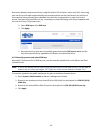
49
Next, you must register the Public Key as an Authorized Key on the Slave. In the simple case with only
one Master with multiple Slaves, you need only upload the one RSA or DSA public key for each Slave.
Note The use of key pairs can be confusing because in many cases one file (Public Key) fulfills two
roles – Public Key and Authorized Key. For a more detailed explanation, refer to the Authorized
Keys section of Chapter 15. Also refer to this chapter if you need to use more than one set of
Authorized Keys in the Slave
Select System: Administration on the Slave’s Management Console
Browse again to the stored RSA (or DSA) Public Key and upload it to Slave’s SSH Authorized Key
Click Apply
The next step is to Fingerprint each new Slave-Master connection. This once-off step will validate that
you are establishing an SSH session with the correct target. On the first connection the Slave will receive
a fingerprint from the Master which will be used on all future connections:
To establish the fingerprint, first log in the Master server as root and establish an SSH
connection to the Slave remote host:
# ssh remhost
Once the SSH connection has been established, you will be asked to accept the key. Answer yes and the
fingerprint will be added to the list of known hosts. For more details on Fingerprinting, refer to Chapter
15.6
If you are asked to supply a password, then there has been a problem with uploading keys. The
keys should remove any need to supply a password.


















